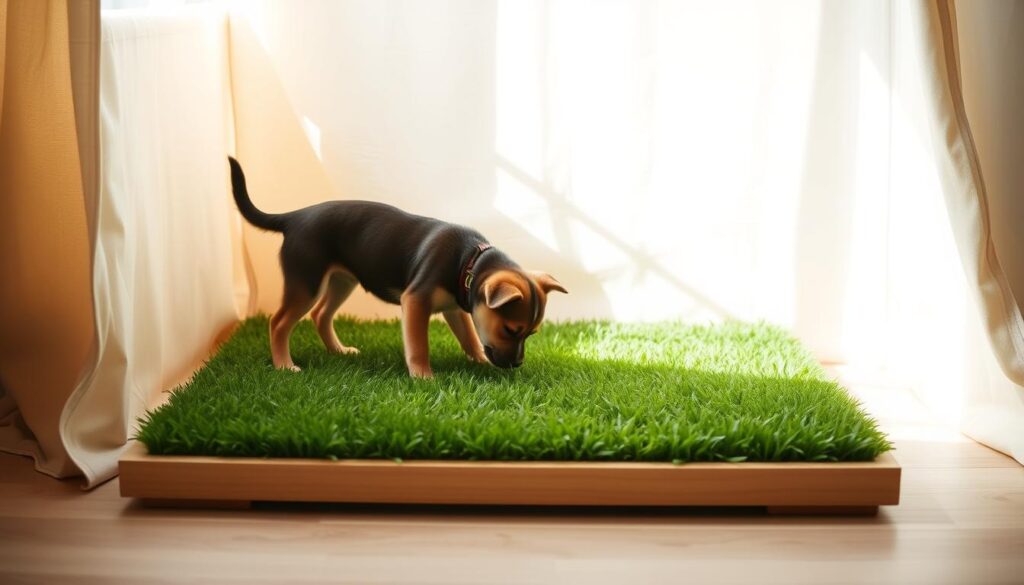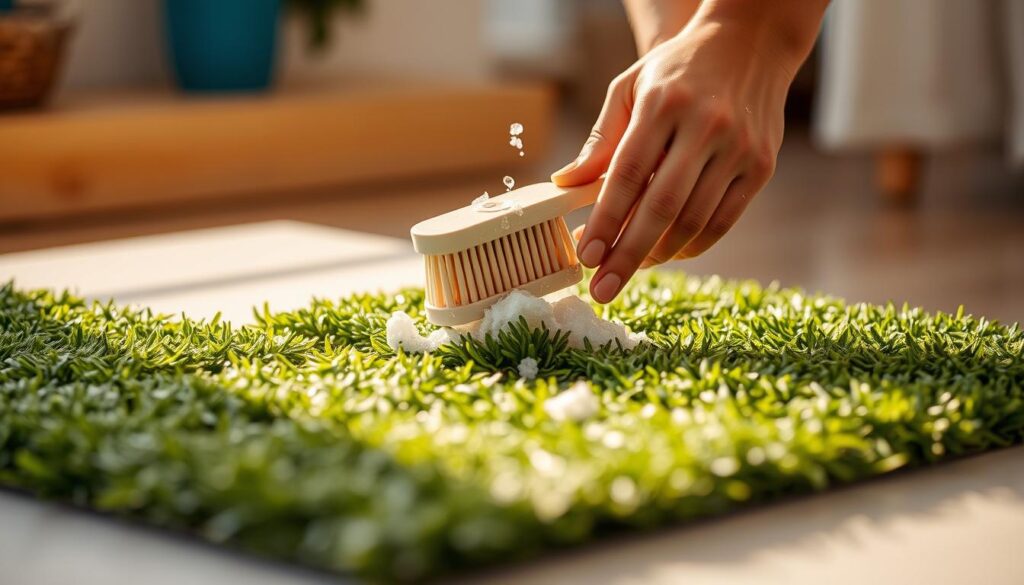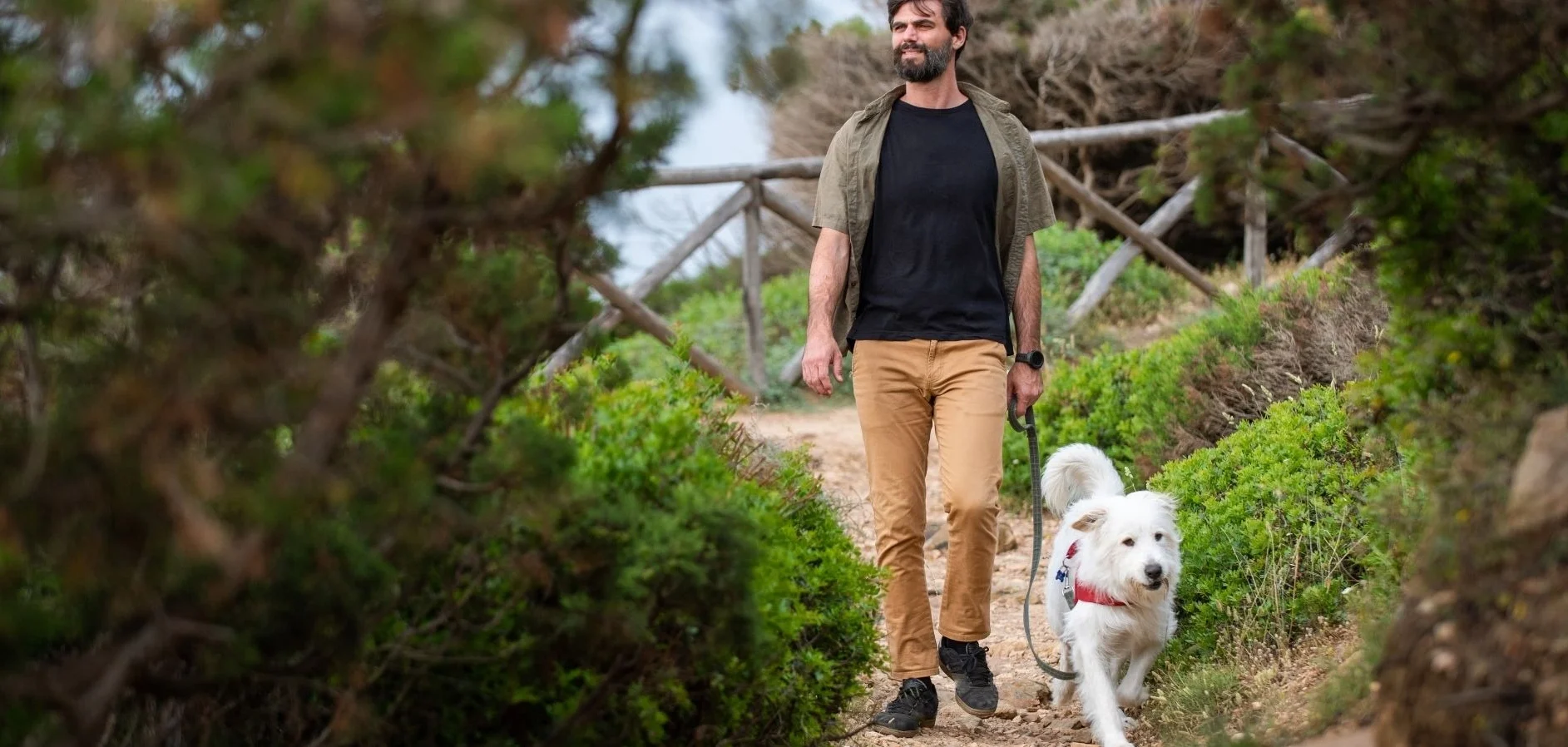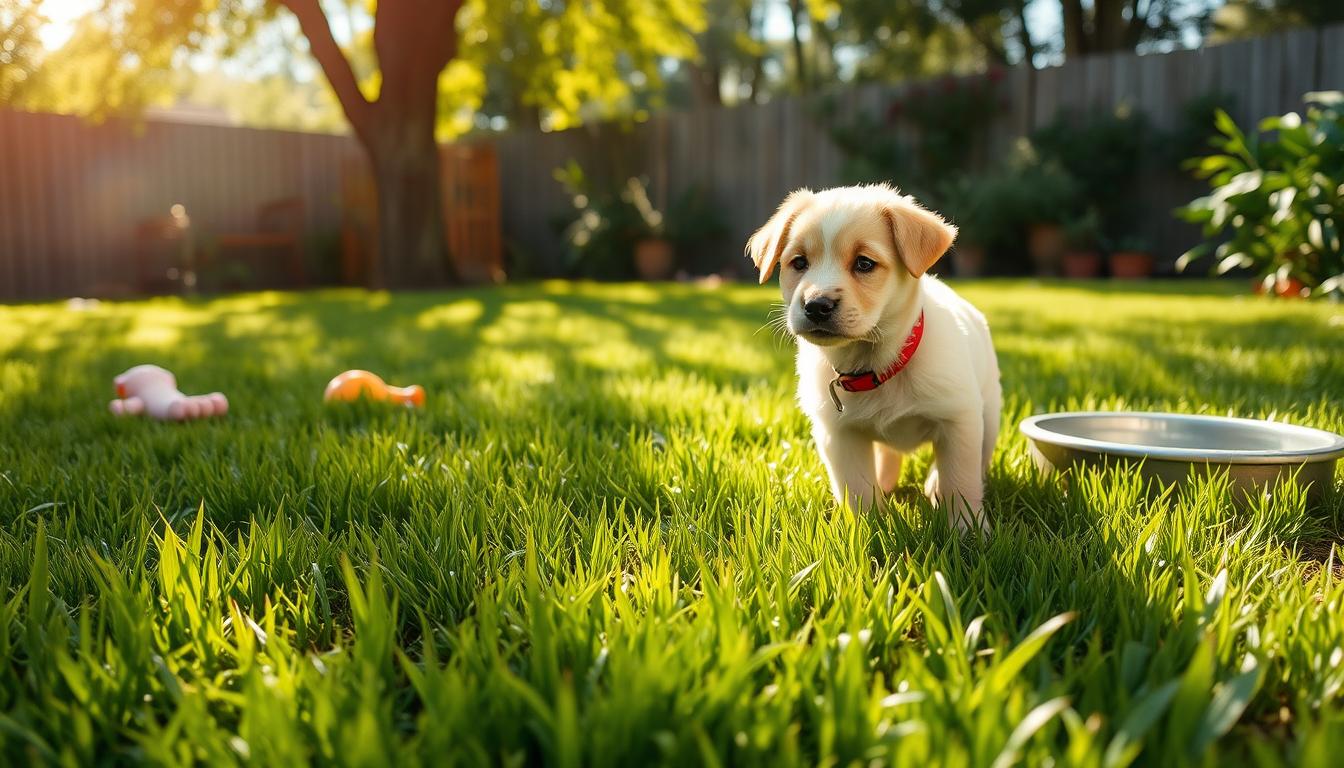Puppy Potty Grass: 5 Ultimate Tips to Train Your Beloved Pup
Every new puppy parent faces the challenge of housetraining. That moment when your puppy looks at you with those innocent eyes while making a mess can be overwhelming. Puppy potty grass is a game-changer for urban dog owners with little outdoor space and busy lives.
Indoor dog potty solutions have changed pet care. They offer a practical and stress-free way to teach your puppy where to go. Whether you live in a high-rise or have limited outdoor access, puppy potty grass is a reliable training method. It mimics natural outdoor environments.
This approach doesn’t just solve a practical problem. It also builds a strong bond of communication and trust between you and your puppy. By understanding puppy potty grass, you’ll turn frustration into a positive training experience.
Key Takeaways
- Puppy potty grass provides a practical solution for urban pet owners
- Indoor dog potty systems simulate natural outdoor environments
- Effective housetraining reduces stress for both puppies and owners
- Consistent training leads to faster learning and better habits
- Adaptable for various living situations and dog breeds
What is Puppy Potty Grass?
Dog owners looking for an easy housetraining solution have found puppy potty grass. It’s a special area for your dog to go to the bathroom comfortably and safely.
Puppy potty grass comes in two types: natural and artificial turf for dogs. Each type has its own benefits for a puppy’s potty area in your backyard.
Definition and Core Purpose
A puppy potty grass is a special surface for dogs to use as a bathroom. It can be used indoors or outdoors, giving pet owners more options.
- Creates a consistent potty training environment
- Mimics natural grass texture
- Helps establish clear bathroom boundaries
Key Benefits of Puppy Potty Grass
Getting a good puppy potty grass system can change your housetraining game. These surfaces have key benefits:
- Odor Control: They keep smells down
- Easy Maintenance: They’re simple to clean and replace
- Comfort for Puppies: They’re soft and feel like real grass, helping puppies use them right
Choosing natural grass or artificial turf, a well-made potty area for puppies can make training easier. It also keeps your pet’s area clean and safe.
The Different Types of Puppy Potty Grass
Choosing the right grass for pet potty training is key. Your dog needs a comfy and effective spot that fits your home and life. Let’s look at the two main puppy potty grass options that can help with housetraining.
Pet owners have two main choices: natural grass and synthetic grass for dogs. Each has its own benefits and things to think about that can affect your training.
Natural Grass Options
Natural grass gives your puppy a real outdoor feel. You can choose from:
- Real sod patches
- Grass seed trays
- Biodegradable grass mats
Advantages of natural grass include:
- Authentic outdoor texture
- Environmentally friendly
- Familiar scent for dogs
Artificial Grass Products
Synthetic grass for dogs is a tough and easy-to-care-for choice. It’s made for pet potty training.
“Synthetic grass provides consistent training surfaces that are easy to clean and maintain.” – Professional Dog Trainer
Artificial grass has key features like:
- Long-lasting durability
- Quick drainage systems
- Easy sanitization
- Consistent training surface
When picking between natural and synthetic, think about your home, budget, and your puppy’s needs. Both can work well for pet potty training if used right and consistently.
How to Choose the Right Puppy Potty Grass
Finding the right dog toilet solutions is important. You need to think about your needs and your dog’s special traits. There are many styles of grass pads for dogs, making it both fun and challenging.
- Size of your living space
- Your dog’s breed and age
- How often you’ll use it
- Your budget
Essential Factors to Consider
Choosing the right grass pads for dogs is about finding a balance. Think about these important points:
- Durability: Pick materials that can handle frequent use
- Portability: Opt for easy-to-move and clean options
- Absorbency: Make sure the pad can handle your dog’s waste well
Brand Comparison
We’ve made a detailed comparison of top grass pad brands to help you decide:
| Brand | Price Range | Size Options | Durability Rating |
|---|---|---|---|
| PetSafe | $29-$49 | Small, Medium, Large | 4.5/5 |
| Bark Potty | $39-$59 | Small, Large | 4/5 |
| Fresh Patch | $25-$45 | Standard | 4.2/5 |
The best dog toilet solutions fit your home and your dog’s needs. Take your time to research and test different options. This way, you’ll find the perfect one.
Setting Up Puppy Potty Grass Indoors
Setting up a good indoor dog potty area for your puppy needs careful planning. The right spot makes housetraining easier for both you and your puppy.

Choosing the right spot for your puppy’s potty grass is key. It should be quiet, easy to get to, and private. This makes quick bathroom breaks a breeze.
Ideal Indoor Locations for Puppy Potty Grass
- Laundry room with easy-to-clean floors
- Bathroom with good ventilation
- Enclosed balcony or utility area
- Corner of a home office or spare room
Critical Placement Considerations
| Location Factor | Recommended Approach |
|---|---|
| Distance from Food Area | At least 5-6 feet away from feeding stations |
| Flooring Type | Non-porous, easily cleanable surfaces |
| Traffic Flow | Low-traffic area with minimal disruptions |
| Accessibility | Easy for puppy to reach quickly |
Keeping your indoor dog potty clean is vital. Regular cleaning stops odors and keeps it clean. Use special cleaners for pet accidents to get rid of bacteria and smells.
Essential Maintenance Tips
- Clean the potty grass daily
- Replace or wash grass patches weekly
- Use odor-neutralizing sprays
- Keep backup cleaning supplies nearby
Finding the right indoor dog potty setup takes time and patience. Watch your puppy’s behavior and adjust the location or type of potty grass as needed. This will help you find the perfect spot for your home.
Using Puppy Potty Grass Outdoors
Creating the perfect backyard potty area for puppies requires careful planning. Your outdoor space can be an ideal training ground for your furry friend. This is true whether you have a big yard or a small balcony.
Dogs need consistent and comfortable potty spaces. These spaces should protect them from harsh weather. Artificial turf for dogs is a versatile solution for pet owners looking for a reliable outdoor bathroom area.
Preparing Your Outdoor Space
When setting up a backyard potty area for puppies, consider these key factors:
- Choose a level surface away from high-traffic zones
- Ensure proper drainage to prevent water accumulation
- Select an area with partial shade
- Create a dedicated space that’s easily accessible
Weather Considerations for Outdoor Potty Areas
Different climates demand specific strategies for maintaining your puppy’s outdoor potty space:
| Climate Type | Recommended Action |
|---|---|
| Hot Regions | Use UV-resistant artificial turf, provide shade |
| Cold Regions | Install raised platforms, use waterproof materials |
| Rainy Areas | Implement good drainage, use water-resistant surfaces |
Remember that consistency is key when establishing an outdoor potty routine for your puppy. Regularly clean and maintain the area. This encourages proper usage and hygiene.
Potty Training Techniques with Puppy Potty Grass
Pet potty training needs patience, consistency, and the right tools. Puppy potty grass is a great tool for training your furry friend. Knowing the best techniques makes training easier for both you and your puppy.
Starting with a clear routine is key to successful pet potty training. Puppies love predictability and structure. Your goal is to create a consistent schedule for them to learn where and when to use their puppy potty grass.
Creating a Consistent Potty Schedule
- Take your puppy to the potty grass immediately after waking up
- Schedule potty breaks every 2-3 hours during the day
- Always take them out after meals and playtime
- Plan a final potty break before bedtime
Positive Reinforcement Strategies
Rewards are important in pet potty training. When your puppy uses the puppy potty grass correctly, praise and treats are great rewards.
| Reward Type | Effectiveness | Timing |
|---|---|---|
| Verbal Praise | High | Immediate |
| Small Treats | Very High | Within 3 seconds |
| Gentle Petting | Moderate | Immediately after success |
Remember, patience is crucial in pet potty training. Every puppy learns at their own pace. Stay consistent and positive throughout the training.
Common Mistakes in Housetraining
Housetraining a puppy needs patience, understanding, and a smart plan. Many pet owners face challenges with dog toilet solutions, especially for puppies. Knowing and avoiding common mistakes can greatly help your training.
Overlooking Size and Breed Needs
Different dog breeds have their own potty training needs. A one-size-fits-all method can cause frustration for both you and your puppy. It’s important to consider these key factors:
- Puppy size and breed-specific traits
- Bladder control capacity
- Energy levels and temperament
“Understanding your puppy’s individual needs is the first step to successful housetraining.” – Professional Dog Trainer
Inconsistency in Training
Consistent training is key when using dog toilet solutions. Irregular schedules and mixed signals confuse your puppy and slow learning.
| Training Mistake | Recommended Solution |
|---|---|
| Irregular potty breaks | Establish a strict schedule |
| Punishing accidents | Use positive reinforcement |
| Changing training methods | Stick to one consistent approach |
By avoiding these common mistakes and focusing on your puppy’s unique needs, you’ll have a more effective and stress-free housetraining experience with best potty grass for puppies.
Cleaning and Maintenance of Puppy Potty Grass
Keeping your synthetic grass for dogs clean is key for your pet’s health and the grass’s life. Regular care keeps the potty area clean and stops bad smells and germs.

Regular cleaning keeps your dog’s area fresh and clean. Your grass pad needs constant care to stay good and comfy.
Routine Cleaning Practices
- Remove solid waste right after your dog uses the grass pad
- Rinse the synthetic grass for dogs with clean water every day
- Use pet-safe enzymatic cleaners for quick disinfection
- Air dry the grass pads for dogs completely after cleaning
Deep Cleaning Methods
Deep cleaning gets rid of tough smells and germs that build up over time.
| Cleaning Method | Frequency | Benefits |
|---|---|---|
| Enzymatic Cleaner Treatment | Weekly | Breaks down organic matter and neutralizes odors |
| Thorough Washing | Bi-weekly | Removes deep-seated dirt and bacteria |
| Replacement of Grass Pad | Every 3-6 months | Ensures maximum hygiene and performance |
Pro tip: Always follow the manufacturer’s specific cleaning instructions for your synthetic grass for dogs to maintain its quality and effectiveness.
Transitioning from Puppy Potty Grass to Outdoor Potty
Pet potty training needs patience and a good plan. As your puppy grows, it’s time to move from indoor potty grass to a backyard potty area. This step helps your puppy learn better bathroom habits and become more independent.
It’s key to know when to start outdoor potty training. Young puppies need constant help during this critical time.
Signs Your Puppy is Ready for Outdoor Potty
- Consistently holds bladder for 2-3 hours
- Shows interest in going outside
- Demonstrates understanding of basic commands
- Displays increased bladder control
Gradual Transition Techniques
- Start with short outdoor potty breaks
- Gradually reduce indoor potty grass usage
- Use positive reinforcement
- Maintain consistent schedule
| Age Range | Transition Strategy | Frequency of Outdoor Trips |
|---|---|---|
| 8-12 weeks | Introduce outdoor potty area | Every 1-2 hours |
| 3-6 months | Reduce indoor potty grass | Every 2-3 hours |
| 6+ months | Complete outdoor transition | 4-5 times daily |
For a smooth transition, you need patience and consistent training. Every puppy learns at their own speed. So, adjust your training to fit your dog’s needs.
Success Stories: Real-Life Experiences
Pet owners all over the United States have found a game-changer in puppy potty grass. It solves tough housetraining problems. Whether you live in a small city apartment or a big suburban house, indoor dog potty solutions have changed the way families handle their pets’ bathroom needs.
Sarah Rodriguez from Seattle had a breakthrough with her rescue Chihuahua. The dog had trouble with regular potty training. But with puppy potty grass in her apartment, accidents dropped a lot. Her little dog learned to use the indoor potty space, making life easier for both of them.
Dog trainers say using puppy potty grass makes housetraining much better. It’s especially helpful for families with no outdoor space or busy schedules. This makes training easier and less stressful for pets and their owners.
Real-life stories show that puppy potty grass is more than a quick fix. It’s a lasting solution for housetraining. No matter where you live, these tools can make your home cleaner and more peaceful with your pet.
FAQ
What exactly is puppy potty grass?
Puppy potty grass is a special indoor or outdoor toilet for dogs. It comes in natural and synthetic forms. It looks and feels like real grass, making it easy to train puppies and manage bathroom needs in small spaces.
How often should I replace my puppy potty grass?
The time to replace it varies by type. Synthetic grass pads last 1-3 months with care. Natural grass patches need replacing every 2-4 weeks. Watch for wear and odor to know when to replace it.
Can puppy potty grass be used for adult dogs?
Yes, it works for adult dogs too, especially in small homes. It’s great for senior dogs, dogs with mobility issues, or pets with irregular schedules.
How do I clean and maintain puppy potty grass?
For synthetic grass, clean up solid waste and rinse with enzymatic cleaner. For natural grass, remove waste daily and replace when soiled. Use disinfectants and odor-neutralizers to keep it fresh and clean.
Is puppy potty grass environmentally friendly?
Natural grass is better for the environment because it’s biodegradable. Some synthetic grass is made from recycled materials. Look for eco-friendly brands if you care about the environment.
How long does it take to train a puppy using potty grass?
Training time depends on the puppy’s age, breed, and learning speed. It usually takes 4-6 weeks. Younger puppies might learn faster, while older dogs need more time.
Can I use puppy potty grass in multiple locations?
Yes, you can place it in different spots like balconies, patios, or indoor areas. Keep the location consistent to help your puppy learn where to go.
What are the cost considerations for puppy potty grass?
Prices range from to 0, depending on the type and brand. Synthetic grass is cheaper in the long run, while natural grass needs more frequent replacement. Think about your budget and your dog’s needs when choosing.
Are there specific breeds that benefit more from puppy potty grass?
Small breeds, toy dogs, and apartment dogs benefit most. Dogs with small bladders or frequent urination find it helpful. Most dogs can use potty grass with training.
How do I transition my puppy from potty grass to outdoor bathroom breaks?
Start by moving the potty grass closer to the outdoor area. Gradually reduce the grass size while increasing outdoor breaks. Use praise and rewards to help your puppy adjust.
There are no reviews yet. Be the first one to write one.


